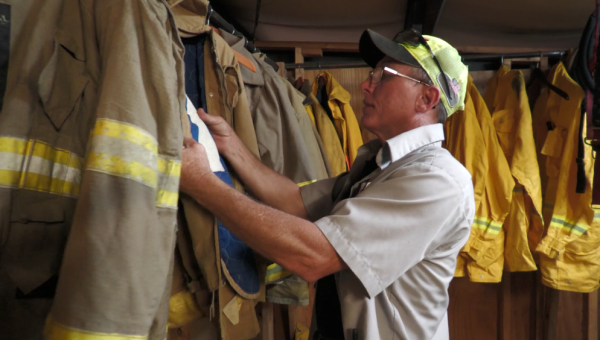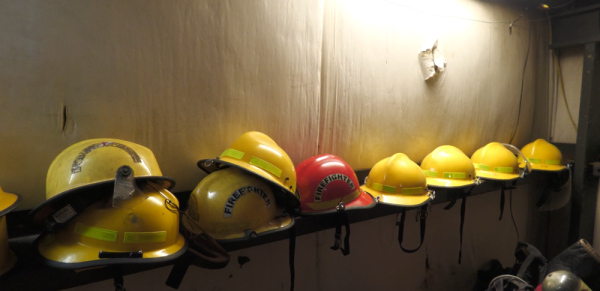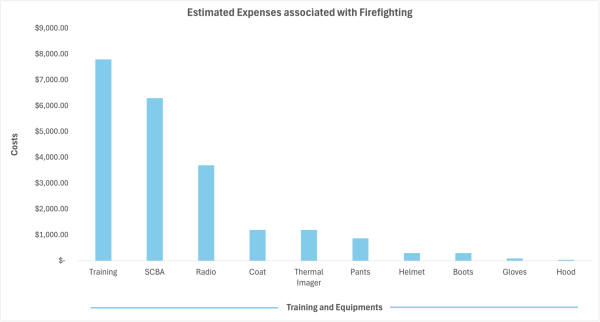PERKINSTON — The jacket Thomas Muffler wears to fight fires is 13 years old. Many hanging on the rack at the McHenry-Sunflower Volunteer Fire Department in Stone County are even older.
“This is from the first grant that we got in 2003,” Muffler said as he picked through the rack of protective gear. “This one is to the point that you can’t even read (the date).”
Muffler leads a fire department with 41 volunteers. Of those, only six have gear that meets the current national safety standards, which recommends gear be replaced every 10 years.

“If I could outfit every one of them with brand new gear, then I would in a heartbeat,” Muffler said. “But it just costs so much to outfit one firefighter. It is hard to stay in compliance.”
Basic turnout gear — the coat, pants, boots, gloves and hood — can cost between $3,000 and $4,000 per firefighter, according to Muffler. He said his department is forced to “pick and choose who gets what based on training and them showing up, responding.”
Even though some of the gear has never seen a fire, it can still be unsafe in a burning building, he said.
“The material starts deteriorating over time — sunlight breaks it down,” he said. “Am I going to put somebody in a fire with it? Probably not.”
Patching gear, sharing radios
Muffler said his department is making do with what they have — but the challenges and risks are growing.
“We have been piecing radios together,” he said. “Some of the guys have actually just gone and bought their own radio.”
Others rely on a scanner app, which Muffler said has major drawbacks, especially when it comes to emergency response.
“If you’re in a part of the county that has poor service, it may be an hour before you get that page,” he said. “If something goes south too quick, you need to be able to talk on the radio. If it’s a hazmat situation, and you’re (the) first person there, it may be too late for you, but you can stop others from coming in. If there’s no communications, then they’re just going to keep piling and piling in, and now you’re down your whole crew because nobody knew that it was hazardous material.”
For now, the McHenry-Sunflower Volunteer Fire Department is finding ways to work-around the problem.
“My wife, actually, when a call goes out, she starts calling and saying, ‘Hey, I need you to get this truck. I need you to go here and do this.’ She’s trying to organize by phone because we have poor communication,” Muffler said.

When it comes to other protective equipment, Muffler said they take parts from ol helmets to fix the ones they currently use.
“We’re kind of getting poor on helmets,” Muffler said as he looked over the row of helmets. “These have been robbed for parts and pieces to fix other helmets, and what’s left is the shells.”
Limited funds mean few solutions for upgrades and new equipment, the chief noted.
Big costs, small budget
The total budget for fire services in Stone County is about $188,000, according to county Fire Coordinator Todd Cospelich. Of that, about $105,000 comes from state insurance rebate monies, which are funds from insurance premium taxes earmarked for county volunteer fire departments.
Stone County, like many rural areas, has limited local tax revenue, and it fluctuates yearly. The county collects four mills in property tax for fire services, bringing in less than $90,000 annually.
“Stone County’s not the most well-funded county. I did a grant for a brush truck out at the Silver Run station in 2010. At that time, four (mills) was $86,000,” said Assistant District Chief Ian Schairer. “In Jackson, one mill was $1.2 million.”
Most of the fire service’s funding goes toward keeping aging trucks operational. New fire trucks can cost more, so departments keep older trucks running as long as they can.
“If you got $10,000 to fix one or $650,000 to buy a new one, that $10,000 is looking better and better,” Cospelich said.
Even so, maintenance is costly. One truck in Muffler’s department required $1,700 in repairs due to bad fuel.
“It’s been an expensive month,” Cospelich said in March. “Over $10,000 in repairs, and we’ll be spending an additional $5,000 for new tires on one truck. At least $50,000 (annually) goes toward maintenance and fuel.”

While the county saves some money by conducting firefighter training internally or through the Mississippi State Fire Academy, there’s no getting around the price of gear.
“We got 73 people,” Cospelich said. “It’s impossible to replace everything out at one time with the county funds. We rely on grants pretty heavily.”
Grants keep the department alive — when they come
Grants are essential for keeping rural fire departments running. In 2023, Stone County received $427,000 from the FEMA’s Assistance to Firefighters Grant Program. The money replaced outdated breathing equipment and a cascade system used to refill air packs.
“We had five different brands of air packs,” Cospelich said. “Some of them had were no longer made, couldn’t get parts, couldn’t service them.”
The grant allowed all Stone County firefighters — both career and volunteer — to work with the same equipment for the first time.
But other applications — including requests for new gear and 62 radios — were denied due to limited federal funds.
“If they had the money, we would have gotten them,” Cospelich said. “But they ran out of money before they got to me.”
“Everything is so expensive. (Radios) are around $6,000, so you’re talking about 62 times $6,000 — so big dollars.” he explained. “They kind of prioritize it and give it until they run out of money, and we were below that line.”
Can the volunteer model survive?
To recruit and retain volunteers, the county offers a small financial incentive.
“The county does pay a stipend,” Cospelich explained. “Now, once a month, I run a report that shows me how many people, you know, how many calls this person went to that month, and every quarter I turn it in, and if they’ve been on 10 calls, they get $100.”

While the money is minimal, it helps cover transportation costs and encourages participation, which also strengthens the department’s grant applications.
At the state level, legislators passed House Bill 521 in 2023, establishing the Length of Service Award Program. It allows eligible volunteer firefighters to receive $500 annually, building up over years of service.
Despite the dangers and costs, Stone County firefighters will continue to show up — even when their equipment is well beyond its recommended lifespan.
“If it comes down, push to shove, they’re going to do it. They’re going to go,” Muffler said. “That’s what we do.”
But county leaders like Cospelich question how long this model can survive.
“At some point — it could be 10 years, it may be 15 years at some point — I don’t know if volunteer service will exist,” he said.
Cospelich predicts volunteer firefighters will be replaced with either paid part-time or full-time personnel.
Some counties, like Harrison, have already moved to fully paid departments, according to Cospelich. Others, like Calhoun, still operate entirely with volunteers.
“At some point, it may go away, but in Stone County, I think it’s going to be here for a good while, just because we have the people dedicated to do it,” Cospelich said.